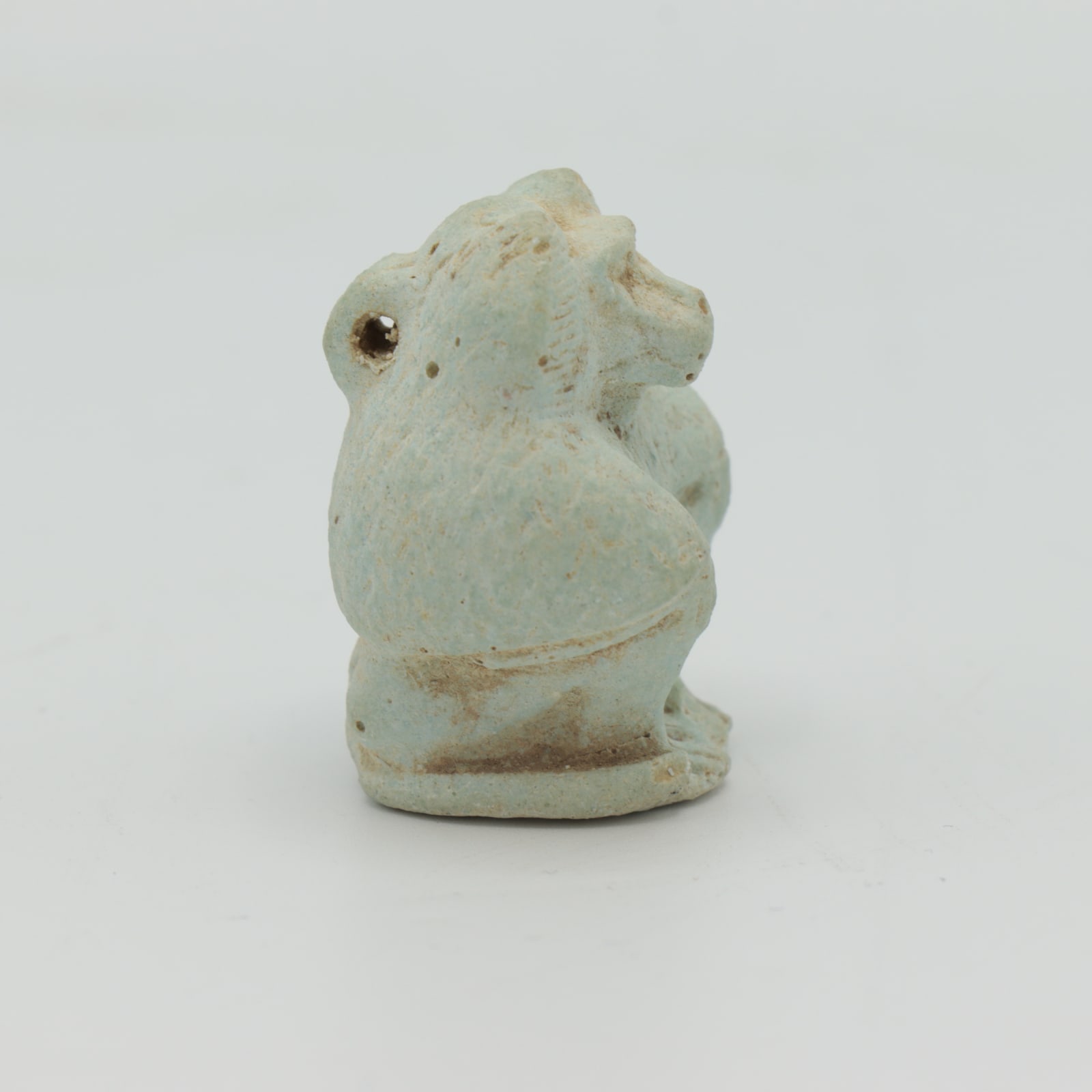New Kingdom Baboon Amulet, 16th-11th century BCE
Faience
height 3.7 cm
height 1 1/2 in
height 1 1/2 in
EL.0066
Further images
This miniature sculpture of a baboon probably represents the god Thoth, who was often depicted in this form or with the head of an ibis. He was the god of...
This miniature sculpture of a baboon probably represents the god Thoth, who was often depicted in this form or with the head of an ibis. He was the god of the moon, wisdom, knowledge, writing, hieroglyphs, science, magic, art, and judgement. He was thought to be self-begotten, and had an important role within the creation of the world. He is said to have made the calculations for the establishment of the heavens and the earth, and to have the responsibility of maintaining the universe. In mythology, he is often seen carrying out clever plans, such as gambling with the moon for a proportion of its light in order to gain five extra days, allowing Nut (who was sterile for the other 360) to give birth to Osiris, Set, Isis and Nephthys. The invention of writing and Egyptian hieroglyphs is attributed to him, so he was worshipped especially by scribes. He was also assigned a role in arbitrating divine disputes and judging the dead; in the form of an ape called Aani, he was the god of equilibrium and was responsible for reporting when the scales weighing the deceased’s heart against a feather were exactly even (if the heart was lighter than the feather, then the deceased had led a virtuous life and was allowed to continue to Aaru, the heavenly paradise. If it was heavier, the deceased was condemned to remain in the underworld, and their heart was devoured by the goddess Ammit).
Here, the baboon is sitting in a crouched position, with its hands resting upon its knees. Its tail is curled around the base of the sculpture, and incised lines represent the texture of its fur. A loop at the top of its back would allow it to be suspended on a string and perhaps worn as a necklace. Its small size means that it could have been carried round easily, and it was probably intended to be used as an amulet. The owner may have believed that it could transfer magical positive properties to them or ward away negative energies. Perhaps, because of its associations with the god Thoth, it was hoped that it might bring the owner wisdom.
The New Kingdom was the most prosperous period of ancient Egypt, when it was at the peak of its power. It covered the 18th, 19th, and 20th Dynasties, spanning from around 1550 BCE to 1069 BCE. During this period, Egypt expanded its power into the Levant and Nubia, attaining the furthest extent that its territory ever reached. Some of Egypt’s most famous rulers were in power during this time, including Hatshepsut, Akhenaten and Nefertiti, and Tutankhamun, as well as Ramesses I and the ten successors who adopted his name. The wealth attained during this period allowed for a great deal of new building, including Luxor Temple, Malkata Palace, and the Ramesseum. A lot of art was also produced, including many sculptures like this one.
Here, the baboon is sitting in a crouched position, with its hands resting upon its knees. Its tail is curled around the base of the sculpture, and incised lines represent the texture of its fur. A loop at the top of its back would allow it to be suspended on a string and perhaps worn as a necklace. Its small size means that it could have been carried round easily, and it was probably intended to be used as an amulet. The owner may have believed that it could transfer magical positive properties to them or ward away negative energies. Perhaps, because of its associations with the god Thoth, it was hoped that it might bring the owner wisdom.
The New Kingdom was the most prosperous period of ancient Egypt, when it was at the peak of its power. It covered the 18th, 19th, and 20th Dynasties, spanning from around 1550 BCE to 1069 BCE. During this period, Egypt expanded its power into the Levant and Nubia, attaining the furthest extent that its territory ever reached. Some of Egypt’s most famous rulers were in power during this time, including Hatshepsut, Akhenaten and Nefertiti, and Tutankhamun, as well as Ramesses I and the ten successors who adopted his name. The wealth attained during this period allowed for a great deal of new building, including Luxor Temple, Malkata Palace, and the Ramesseum. A lot of art was also produced, including many sculptures like this one.











